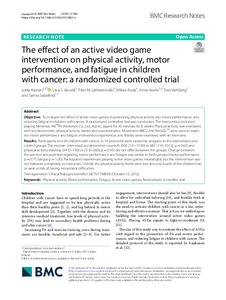The effect of an active video game intervention on physical activity, motor performance, and fatigue in children with cancer: a randomized controlled trial
Hamari L; Järvelä LS; Lähteenmäki PM; Arola M; Axelin A; Vahlberg T; Salanterä S
https://urn.fi/URN:NBN:fi-fe2021042823966
Tiivistelmä
Objective
To evaluate the effect of active video games in promoting physical activity and motor performance, and reducing fatigue in children with cancer. A randomized controlled trial was conducted. The intervention included playing Nintendo Wii™Fit (Nintendo Co., Ltd., Kyoto, Japan) for 30 min/day for 8 weeks. Physical activity was estimated with accelerometers, physical activity diaries and questionnaires. Movement-ABC2 and PedsQL™ were used to examine motor performance and fatigue. Intervention experiences and fidelity were examined with an interview.
Results
Participants (n = 36 children with cancer, 3–16 years-old) were randomly assigned to the intervention and control groups. The median [min–max] accelerometer counts/h (500 [131–1130] vs 385 [116–1012], p = 0.63) and physical activity min/day (34 [0–150] vs 23 [0–260], p = 0.95) did not differ between the groups. Change between the pre-test and post-test regarding motor performance and fatigue was similar in both groups (motor performance p = 0.77; fatigue p = 1.00). Participants experienced playing active video games meaningful, but the intervention was not followed completely as instructed. Overall, the physical activity levels were low and one fourth of the children had or were at risk of having movement difficulties.
Kokoelmat
- Rinnakkaistallenteet [27094]
